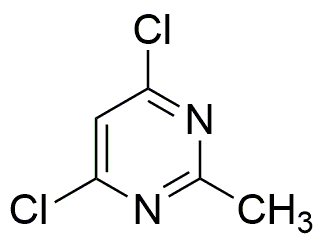4,6-Dichloro-2-methylpyrimidine is widely utilized in research focused on:
- Agricultural Chemistry: This compound is effective as a herbicide, helping to control unwanted plant growth, which is essential for improving crop yields and managing weeds in various agricultural settings.
- Pharmaceutical Development: It serves as an intermediate in the synthesis of various pharmaceuticals, particularly in the development of antiviral and antibacterial agents, enhancing the effectiveness of treatments.
- Material Science: Used in the formulation of specialty coatings and polymers, it contributes to improved durability and resistance to environmental factors, making it valuable in manufacturing processes.
- Research Applications: This compound is utilized in laboratory settings for studying nucleic acid interactions, aiding researchers in understanding genetic mechanisms and developing new biotechnological applications.
- Environmental Science: It plays a role in the study of environmental pollutants, helping scientists assess the impact of chemical substances on ecosystems and develop strategies for remediation.
Informations générales
Propriétés
Sécurité et réglementation
Applications
4,6-Dichloro-2-methylpyrimidine is widely utilized in research focused on:
- Agricultural Chemistry: This compound is effective as a herbicide, helping to control unwanted plant growth, which is essential for improving crop yields and managing weeds in various agricultural settings.
- Pharmaceutical Development: It serves as an intermediate in the synthesis of various pharmaceuticals, particularly in the development of antiviral and antibacterial agents, enhancing the effectiveness of treatments.
- Material Science: Used in the formulation of specialty coatings and polymers, it contributes to improved durability and resistance to environmental factors, making it valuable in manufacturing processes.
- Research Applications: This compound is utilized in laboratory settings for studying nucleic acid interactions, aiding researchers in understanding genetic mechanisms and developing new biotechnological applications.
- Environmental Science: It plays a role in the study of environmental pollutants, helping scientists assess the impact of chemical substances on ecosystems and develop strategies for remediation.
Documents
Fiches de données de sécurité (FDS)
La FDS fournit des informations de sécurité complètes sur la manipulation, le stockage et l’élimination du produit.
Spécifications du produit (PS)
Le PS fournit une description complète des propriétés du produit, notamment sa composition chimique, son état physique, sa pureté et les exigences de stockage. Il détaille également les plages de qualité acceptables et les applications prévues du produit.
Certificats d'analyse (COA)
Recherchez des certificats d'analyse (COA) en saisissant le numéro de lot du produit. Les numéros de lot et de lot se trouvent sur l'étiquette d'un produit, après les mots « Lot » ou « Lot de fabrication ».
Numéro de catalogue
Numéro de lot/série
Certificats d'origine (COO)
Ce certificat d'exploitation confirme le pays dans lequel le produit a été fabriqué, et détaille également les matériaux et composants utilisés et s'il est issu de sources naturelles, synthétiques ou autres sources spécifiques. Ce certificat peut être requis pour les douanes, le commerce et la conformité réglementaire.
Numéro de catalogue
Numéro de lot/série
Fiches de données de sécurité (FDS)
La FDS fournit des informations de sécurité complètes sur la manipulation, le stockage et l’élimination du produit.
DownloadSpécifications du produit (PS)
Le PS fournit une description complète des propriétés du produit, notamment sa composition chimique, son état physique, sa pureté et les exigences de stockage. Il détaille également les plages de qualité acceptables et les applications prévues du produit.
DownloadCertificats d'analyse (COA)
Recherchez des certificats d'analyse (COA) en saisissant le numéro de lot du produit. Les numéros de lot et de lot se trouvent sur l'étiquette d'un produit, après les mots « Lot » ou « Lot de fabrication ».
Numéro de catalogue
Numéro de lot/série
Certificats d'origine (COO)
Ce certificat d'exploitation confirme le pays dans lequel le produit a été fabriqué, et détaille également les matériaux et composants utilisés et s'il est issu de sources naturelles, synthétiques ou autres sources spécifiques. Ce certificat peut être requis pour les douanes, le commerce et la conformité réglementaire.


